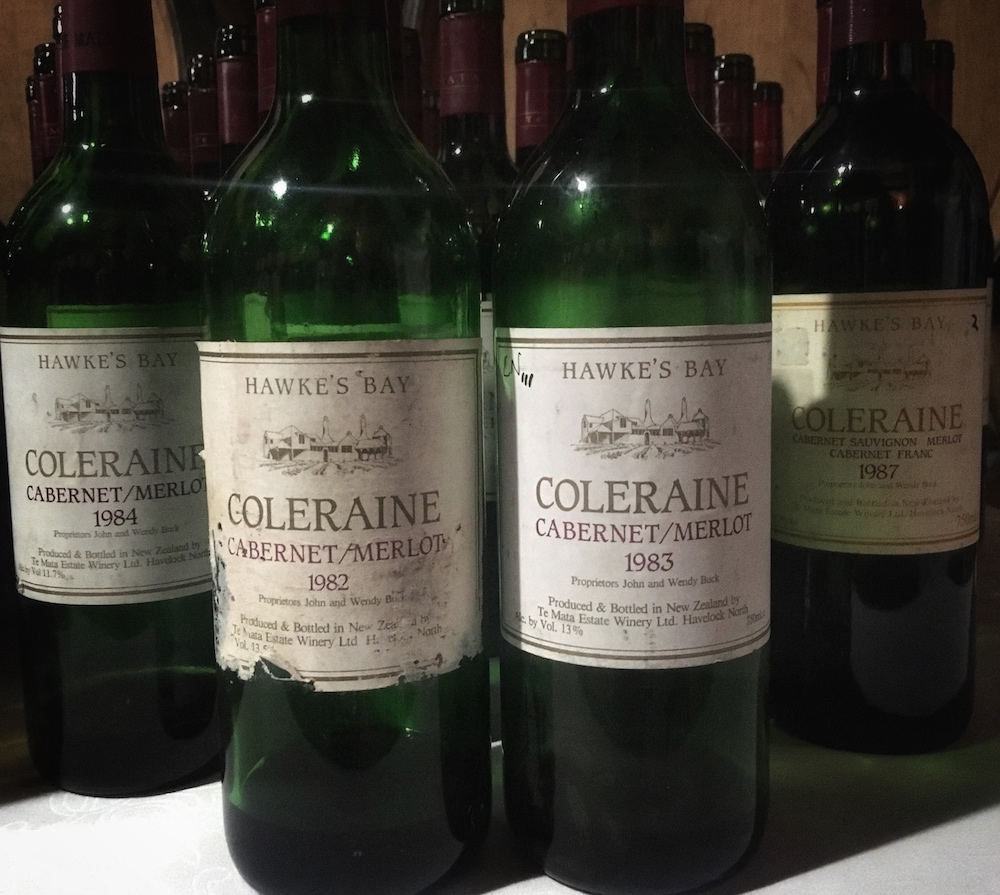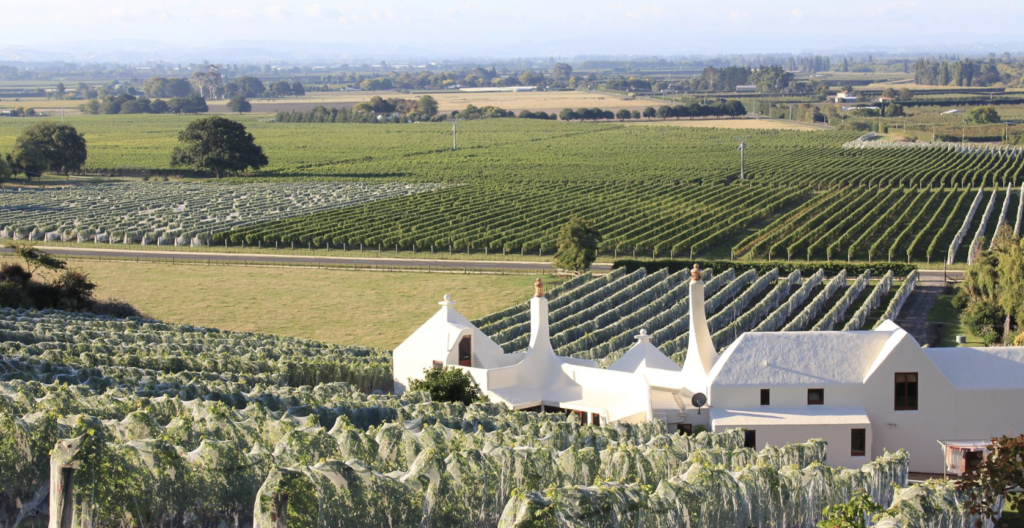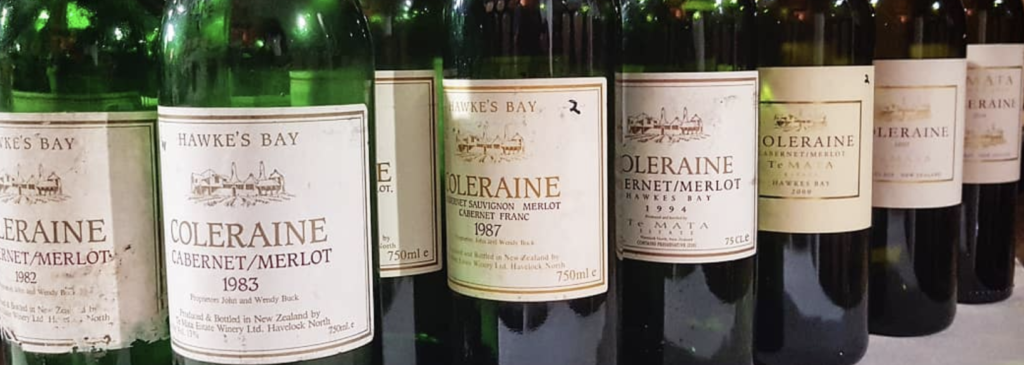Some would say that Te Mata’s Coleraine was the first true iconic wine of New Zealand. The first vintage of Coleraine caused a stir when it came in 1982 but it wasn’t without a precedent. Te Mata Estate had already been making well-respected wines for many years before and the estate, whose first vintage was in 1896, is in fact the oldest winemaking property in New Zealand.
It is partly due to Te Mata’s long history and experience that Coleraine was celebrated quite early on as one of New Zealand’s finest wines. But also because Coleraine hit the nail on the head in terms of combining grape variety with terroir and proved that Hawke’s Bay, and indeed New Zealand, was capable of making world class red blends.
Te Mata Coleraine: The art in the blend
Te Mata Estate has many different soil profiles and mesoclimates in their vineyards. Varying degrees of alluvial gravels, silts and sand make up the vineyard soils and parcels each have different exposures, slopes (or plains) and mesoclimates. This, in combination with the different grape varieties, is what the family believes gives them an advantage in making red blends.
“The absolute strength of Bordeaux blends is in different varieties and different soils, and that’s where we started,” explains Toby Buck, the second generation of the family to run Te Mata Estate. “But it is also really about the people that put these wines together, who made them what they are.”
Te Mata Estate: A family affair
It was a tasting of a Hawke’s Bay red wine (made by Tom McDonald) in 1966 that convinced John Buck to move to the region to make wine. Although the feeling was there from the first sip in ’66, it took several years to find the right place. He and his business partner Michael Morris eventually bought Te Mata Estate in 1974 and the Buck family have been producing Te Mata wines ever since. The success of Te Mata’s wines in the 80s is credited with sparking the revival of Hawke’s Bay as a top wine region.
For the majority of Coleraine’s lifespan, the winemaker has been Peter Cowley. Cowley started in 1984 and, coincidentally, will be retiring at the end of 2018. Effectively there were only two vintages that Cowley didn’t make (1982 and 1983), although he took part in blending the 1983. On tasting the Te Mata Coleraine vertical from 1982 to 2016, there was evidently a progression in winemaking skill, but there were no jarring differences. This consistency, in family and winemaker, is fundamental for a wine to be considered an ‘icon’.
Nuances of vintage, vineyard and grape in Te Mata Coleraine
Vintage played an important role in the differences in the glass, alongside the different grape varieties and vineyards blended. Notably the earlier vintages (1982 until 1988) were all single-vineyard blends from the Coleraine vineyard. However, from 1989 onwards, the wine was made by selecting the finest wines from all of their vineyards in Hawke’s Bay.
The grape variety proportions in the blends also changed quite significantly depending on the year. Cabernet Sauvignon is usually the dominant grape variety but the blend has ranged from 94% Cabernet Sauvignon (in the very first vintage, 1982) down to just 25% in 2002. The rest of the blend is made up of Merlot and, usually to a lesser extent, Cabernet Franc.
Getting to the heart of Te Mata Coleraine
At the core of all the wines was deep spice and dark forest fruit aromas, complimented by floral notes and fine tannins with finesse. The earlier vintages showed a somewhat cooler climate, whether that was from cooler vintages or less ripening through vineyard management, and I personally rather enjoyed the leafier, more savoury style. More popular on the table though were the riper vintages – notably 1998 and 2002 – which showed richer fruit and softer tannins.
One of my favourite wines of the flight was in fact the first vintage (along with 1998), which certainly shows how well Te Mata Coleraine and Hawke’s Bay red blends can age. My overall impression of the vertical was that it didn’t only show the ageing potential here, but also the nuance of the vintage and need to blend.
Much like doing a vertical tasting in the Old World, the wines are quite transparent to the vintage conditions and you can see the winemaker’s artistry in trying to make a consistent wine by blending different varieties in different proportions. (Compared to a vertical from Napa, Mendoza or Maipo for example, where vintages are much more consistent and the iconic wines tend to be a single variety from a single vineyard.) I enjoy a wine that is nuanced and different year to year, and I think Te Mata’s Coleraine showed how sensitive fine New Zealand wines can be to the elements.
Most importantly in terms of style progression is the confidence in Coleraine having its own identity as a wine, rather than mimicking a Bordeaux blend. “Although it might have been inspired by Bordeaux, the thing about Coleraine is that it has really come out of that shadow and it has developed its own voice and style in that time,” said Toby Buck. “When you go through 32 years of Coleraine, we are looking at New Zealand history – we are stepping out of the shadow of Bordeaux and taking pride in New Zealand.”
After the tasting, it was that notion of the winemaker feeling and tasting his way towards the making of the final wine which led me agree with what Toby Buck had said at the beginning of the tasting… Te Mata Coleraine is about the people who put this wine together.
Te Mata Coleraine tasting notes: 1982 to 2016
Wines with a 🌟 are considered Outstanding (or 95+ points, or 18.5+). This vertical was purchased by and provided by Air New Zealand in promotion of their Fine Wines of New Zealand programme.
1982 Te Mata Coleraine 🌟
One of my favourites from the earlier years, the 1982 is led by 94% Cabernet Sauvignon and just 6% Merlot and is holding wonderfully for its age. The wine has complex savoury notes of forest floor and tar with but there are also fruit aromas, like blackcurrant liquor, still underpinning this wine and spice creating tension. Tannins like lace.
1983 Te Mata Coleraine
In this second vintage there is 75% Cabernet Sauvignon with 22% Merlot and 3% Cabernet Franc in the blend. It is still looking very good for its age with fruit, spice and savoury notes, but lacks the finesse of ’82. It was a warmer vintage and has that fuller, fleshier style.
1984 Te Mata Coleraine
This vintage shows slightly more perfume and leather notes with spice on the finish and some sweet dried red fruit. A fragrant and lighter vintage.
1985 Te Mata Coleraine 🌟
This older vintage is also standing up very nicely, with notes of fine cigar tobacco, cedar, spice and fragrant aromas of dried flowers. An enjoyable moment to drink this vintage and one of my favourites from the 80s – smooth, balanced and well-integrated. 72% Cabernet Sauvignon, 25% Merlot and 3% Cabernet Franc.
1986 Te Mata Coleraine
The warmer ’86 vintage presents more fruit on the palate and richer chocolate notes. The finish is smooth but doesn’t have the persistence some of the others – more fruit-forward.
1987 Te Mata Coleraine
This vintage of Coleraine is a little more shy on the nose, with subtle cherry and orange peel notes but on the palate it shows some petrol notes evident of the age.
1988 Te Mata Coleraine
Another warmer vintage, the ’88 has a more fruit-led nose but in the palate it has earthy characters tucked underneath too.
1989 Te Mata Coleraine 🌟
This wine stood out for its different vintage (a very dry year) and also as the first with a high proportion of Merlot (37%). Merlot was still a very new grape variety for New Zealand in the 80s, but this blend (with 54% Cabernet Sauvignon and 9% Cabernet Franc) shows a nice handling of the softer fruit of Merlot with dense berry notes, some perfume and an attractive leafiness to the finish. Smooth and balanced, showing real potential.
1990 Te Mata Coleraine
This warmer vintage offers riper fruit expression with notes of cassis and rose petals and softer, supple tannins that linger. This vintage was similar in composition to 1989, but with 10% Cabernet Franc and 36% Merlot.
1991 Te Mata Coleraine 🌟
The 1991 vintage was celebrated as one of New Zealand’s best at the time and the wine certainly shows more richness and concentration, which is quite becoming for its age (although this vintage could be cellared for much longer). Cedar notes are underpinned by cassis and forest berry aromas. This vintage saw more Cabernet Franc than ever before (12%) and Cabernet Sauvignon was back up to 59%.
1994 Te Mata Coleraine
There was a break in vintages in 1992 and 1993, which were too disrupted by ash from the Pinatubo volcano eruption, so 1994 was the next vintage in the line up. Another savoury wine with some notes of greengage plum, spice and lightly medicinal.
1995 Te Mata Coleraine
A warmer vintage and you can tell this was a powerhouse wine in its youth, but today it is at that delicious stage between balsamic notes and leafy notes with tension in the fine tannins that hold this wine together well.
1996 Te Mata Coleraine
This vintage was a bit more of a mixture in terms of climate but the wine shows full ripeness of fruit with lots of concentration. There are vanilla bean and ashy aromas and the wine finishes with lively tannins and fresh acidity. 53% Cabernet Sauvignon, 33% Merlot and 14% Cabernet Franc.
1997 Te Mata Coleraine
Another warmer vintage with some jammy berry fruit on the nose but great presence and spice on the finish. This is a smart wine with tension and vibrancy.
1998 Te Mata Coleraine 🌟
One of my favourites of the entire tasting, if not the favourite. It was a hot year for Hawke’s Bay, which meant the wine has great fruit concentration. However this vintage is showing beautifully now with complex notes of liquorice, cocoa, cassis and rose petals. It finishes with fine, but notable, tannins which are fleshed out with fruit. It has a bit of everything – some power, some nuance and great length. It showed wonderfully on the day. 60% Cabernet Sauvignon, 32% Merlot and 8% Cabernet Franc.
1999 Te Mata Coleraine
Less concentrated than the 1998, this vintage shows some layers of forest herbs and spice with notes of cedar and sweet fruit on the finish and plenty of follow through.
2000 Te Mata Coleraine
The millenial vintage carries 52% Cabernet Sauvignon, 29% Merlot and a much higher quantity of Cabernet Franc than before (19%) The result is a very fragrant wine with floral aromas, rich red fruit, spice and mushroom notes. It’s a great wine that is slightly overshadowed by its preceding warmer vintages but shows concentration, richness and potential to age longer.
2001 Te Mata Coleraine
This cooler vintage shows some more floral notes of dried flowers and herbs with a savoury finish. There’s spice and length to this wine but less concentration.
2002 Te Mata Coleraine
Another warm year meant the fruit could hang on the vine for a long time and this opportunity perhaps gave way to a totally different blend: just 25% Cabernet Sauvignon, 39% Merlot and 36% Cabernet Franc. The wine still has primary fruit aromas with fleshy notes of bramble and plum, backed by cedar, spice and chocolate.
2003 Te Mata Coleraine
A little more ashen on the nose, this 2003 was a bit shy on the day and shows less complexity than the other vintages. Perhaps one to sit on for a little longer.
2004 Te Mata Coleraine
This vintage has quite sweet fruit notes on the nose. It is a vibrant Coleraine vintage with elegant notes of black tea and exotic spice muddled among the fruit aromas.
2005 Te Mata Coleraine
Another different year for the estate with the latest harvest in their history (on 2 May!) This really long hang time offered a wine with explosive notes of berry and bramble, backed by peppery spice and forest herbs. This vintage is still youthful in the glass, it is a powerhouse wine with a fruit-forward nose backed by great acidity and peppery tannins that give this promise for many more years to come. 37% Cabernet Sauvignon, 45% Merlot and 18% Cabernet Franc.
2006 Te Mata Coleraine
For what the 2005 has in power, the 2006 has in finesse. More perfumed fruit notes and plushness with spice and a lingering finish.
2007 Te Mata Coleraine
Notes of blackcurrant jam and black pepper give an intensity to this Coleraine vintage. Great acidity on the finish keeps it lively and this is still a youthful wine filled with primary fruit aromas.
2008 Te Mata Coleraine
Chocolate, coffee and pepper show that this is still reeling from its barrel time. Intense and taut, I think this shows the turning point of needing to age more.
2009 Te Mata Coleraine
Another record-breaking hot year (I think we can see a pattern emerging!) although this time the blend swings back to favour Cabernet Sauvignon (52%) and Merlot (43%), which gives a much more cassis-driven nose and spice. Still has plenty of cellaring potential and delicious tension to this wine.
2010 Te Mata Coleraine
Despite a hot season, this vintage shows some complexity on the nose. Notes of graphite and garden herbs and flowers add interest to fleshy fruits and cassis aromas led by 58% Cabernet Sauvignon (and 36% Merlot and 6% Cabernet Franc).
2011 Te Mata Coleraine
This vintage shows more plummy aromas and has the coffee and spice notes from the barrel ageing. It feels young and would certainly benefit from some more time in bottle. (There was no 2012 vintage.)
2013 Te Mata Coleraine 🌟
This was one of my favourites among the modern vintages, showing fresh acidity with supple tannins. Aromatically I think the 14% Cabernet Franc helps lead some of the more floral and leafy aromas, alongside the blackberry notes of 56% Cabernet Sauvignon and some fleshy plum notes from 30% Merlot. Opulent but with great acidity to hold it together and perfume to add intrigue.
2014 Te Mata Coleraine 🌟
Another warm vintage for Hawke’s Bay with great fruit ripeness and concentration in this wine but also deliciously heady floral aromas. Complex and full with spicy, but fine, tannins coming from 60% Cabernet Sauvignon with 28% Merlot and 12% Cabernet Franc. Hold onto this vintage longer.
2015 Te Mata Coleraine 🌟
Cooler than the previous years, this vintage errs on the more savoury side with sage and cedar alongside pretty floral notes, cocoa and dark berry notes. 54% Cabernet Sauvignon, 36% Merlot and 10% Cabernet Franc. Still a baby.
2016 Te Mata Coleraine
It’s still very much early days for this Coleraine (51% Cabernet Sauvignon, 47% Merlot and 2% Cabernet Franc) but there’s a lot of promise in this wine with fresh red fruit aromas, leafy garden herb and animal notes. It is taut and has precision. This is one to keep in the cellar and see how it unwinds.
A vertical of Coleraine recently went for $19,000 NZ in an auction (the equivalent of almost $13,000 USD), making it the most expensive auction price achieved for any New Zealand wine collection.



